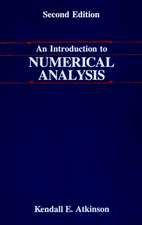The Mathematica GuideBook for Programming
Autor Michael Trotten Limba Engleză Hardback – 28 oct 2004
This first volume begins with the structure of Mathematica expressions, the syntax of Mathematica, its programming, graphic, numeric and symbolic capabilities. It then covers the hierarchical construction of objects out of symbolic expressions, the definition of functions, the recognition of patterns and their efficient application, program flows and program structuring, and the manipulation of lists.
An indispensible resource for students, researchers and professionals in mathematics, the sciences, and engineering.
| Toate formatele și edițiile | Preț | Express |
|---|---|---|
| Paperback (1) | 546.84 lei 6-8 săpt. | |
| Springer – 2 ian 2014 | 546.84 lei 6-8 săpt. | |
| Hardback (1) | 634.31 lei 6-8 săpt. | |
| Springer – 28 oct 2004 | 634.31 lei 6-8 săpt. |
Preț: 634.31 lei
Preț vechi: 746.25 lei
-15% Nou
121.38€ • 127.31$ • 101.04£
Carte tipărită la comandă
Livrare economică 01-15 aprilie
Specificații
ISBN-10: 0387942823
Pagini: 1028
Ilustrații: XXXVIII, 1028 p.
Dimensiuni: 178 x 254 x 53 mm
Greutate: 1.81 kg
Ediția:2004
Editura: Springer
Colecția Springer
Locul publicării:New York, NY, United States
Public țintă
Professional/practitionerCuprins
I Introduction: *Remarks *Basics of Mathematica as a Programming Language *Introductory Examples *What Computer Algebra and Mathematica 4.0 Can and Cannot Do Exercises Solutions References
II Structure of Mathematica Expressions: *Remarks *Expressions *Simple Expressions *Nested Expressions *Manipulating numbers Exercises Solutions References
III Definitions and Properties of Functions: *Remarks *Definition and clearing of simple functions *Options and Defaults *Attributes of Functions *Downvalues and Upvalues *Functions that Remember Their Values *Functions in the x-Calculus *Repeated Application of Functions *Functions of Functions Exercises Solutions References
IV Meta-Mathematica: *Remarks *Information on Commands *Control over Running Calculations and Resources *The $-Commands *Communication and Interaction with the Outside *Debugging *Localization of Variable Names *The Process of Calculation Exercises Solutions References
V Replacement Rules and Related Matters: *Remarks *Boolean Functions *Patterns *Replacement Rules Exercises Solutions References
VI Operations on List, and Linear Algebra: *Remarks *Creating Lists * Representation of Lists *Manipulating on Single Lists *Operations with Several Lists or with Nested Lists *Mathematical Operations with Matrices *Top-ten Built-in Commands Exercises Solutions References Index
Recenzii
"This volume is the first one in a series of four books on the Mathematica programming language. It is best suited for those who … want to learn the sophisticated tricks of the advanced programming and to use Mathematica up to its full capacity. … The book addresses many features of human-computer interaction. … This book is one of the most valuable sources for the advanced users of Mathematica. … all the science/engineering/computer science/mathematics libraries should have this book and its companion volumes." (Matti Vuorinen, Zentralblatt MATH, Vol. 1080, 2006)
"The Mathematica GuideBook for Programming provided this reviewer with insights into solving and visualizing problems by using Mathematica … . Its wealth of exercises, annotated solutions and integrated bibliographic references should make this set a valuable part of the library of any Mathematica user. I highly recommend it." (Marvin Schaefer, MathDL, August, 2006)
"On the whole, the programming GuideBook provides a comprehensive, step-by-step development of Mathematica programming capabilities and contains an impressive collection of examples and worked exercises. Key Mathematica functions are discussed in detail, using interesting examples and put to the test in real programs." (Willy Hereman, SIAM Review, Vol. 47 (4), 2005)
Caracteristici
* Clear organization, complete topic coverage, and an accessible writing style for both novices and experts
* Detailed discussion of procedural, rule-based, and functional programming
* Hundreds of worked examples, illustrations, programs, and fully worked self-study exercises for understanding concepts and learning how to solve real-life problems
* Website for book with additional materials:
http://www/MathematicaGuideBooks.org
Descriere
Mathematica is today’s most advanced technical computing system. It features a rich programming environment, two-and three-dimensional graphics capabilities and hundreds of sophisticated, powerful programming and mathematical functions using state-of-the-art algorithms. Combined with a user-friendly interface, and a complete mathematical typesetting system, Mathematica offers an intuitive, easy-to-handle environment of great power and utility.
The Mathematica Guidebook for Programming provides a comprehensive, step-by-step development of Mathematica programming capabilities and contains an enormous collection of examples and worked exercises. It guides the reader to become fluent in the structure of Mathematica expressions, expression evaluation, pure and named functions, and in procedural, rule-based, and functional programming constructs. Each Mathematica function is discussed in detail, explained in numerous examples. The programs for this book are available to download at the link below: http://extras.springer.com
Unique Features:
* Step-by-step presentation of Mathematica functions assuming no prior Mathematica programming experience
* Clear organization, complete topic coverage, and an accessible writing style for both novices and experts
* Detailed discussion of procedural, rule-based, and functional programming
* Hundreds of worked examples, illustrations, programs, and fully worked self-study exercises for understanding concepts and learning how to solve real-life problems
* Website for book with additional materials: http://www.MathematicaGuideBooks.org
Michael Trott is a symbolic computation and computer graphics expert. He holds a Ph.D. in theoretical physics and joined the R&D team at Wolfram Research in 1994, the creators of Mathematica. Since 1998, he has been leading development of the Wolfram Functions Site http://functions.wolfram.com, which currently features more that 80,000 formulas and identities, and thousands of visualizations.



















